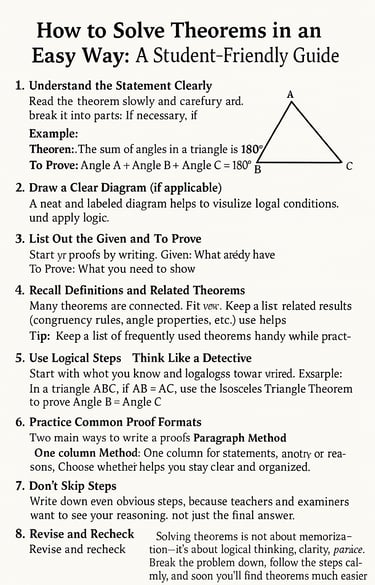How to Solve Theorems in an Easy Way: A Student-Friendly Guide


Solving theorems can seem intimidating at first, but with the right approach, it becomes a logical and even enjoyable process. Whether you’re dealing with geometry, algebra, or calculus, the steps below will help you crack the code of theorem-solving with ease.
1. Understand the Statement Clearly
Before attempting any theorem, read it slowly and carefully. Break it down into simple parts. If needed, rewrite the statement in your own words. Understanding what is given and what needs to be proved is the first step toward solving it.
Example:
Theorem: The sum of angles in a triangle is 180°.
Given: A triangle
To Prove: Angle A + Angle B + Angle C = 180°
2. Draw a Clear Diagram (if applicable)
Most theorems in geometry require visual understanding. A neat and labeled diagram helps to visualize the given conditions and apply logic properly.
3. List Out the Given and To Prove
Always start your proof by writing:
Given: What information you already have
To Prove: What you need to show
This helps organize your thoughts and avoid confusion.
4. Recall Definitions and Related Theorems
Many theorems are connected. If you recall related results (like congruency rules, angle properties, etc.), you can build your proof step-by-step using these.
Tip: Keep a list of frequently used theorems handy while practicing.
5. Use Logical Steps – Think Like a Detective
Start with what you know and logically progress toward what you need to prove. Use small steps and justify each with a rule or theorem.
Example:
In a triangle ABC, if you know AB = AC and you’re trying to prove Angle B = Angle C, use the Isosceles Triangle Theorem.
6. Practice Common Proof Formats
There are two main ways to write a proof:
Paragraph Method: Explained in sentences.
Two-Column Method: One column for statements, another for reasons.
Choose whichever helps you stay clear and organised.
7. Don’t Skip Steps
Even if a step seems obvious to you, write it down. Teachers and examiners want to see your complete reasoning, not just the final answer.
8. Revise and Recheck
After completing the proof, re-read it. Check if every step logically follows from the previous one and if the final statement matches what you needed to prove.
9. Practice, Practice, Practice
The more theorems you solve, the better your understanding. Start with easier ones and gradually move to tougher ones. Try solving one theorem in multiple ways if possible.
Conclusion
Solving theorems is not about memorization—it’s about logical thinking, clarity, and practice. Break the problem down, follow the steps calmly, and soon you’ll find theorems much easier to handle.
